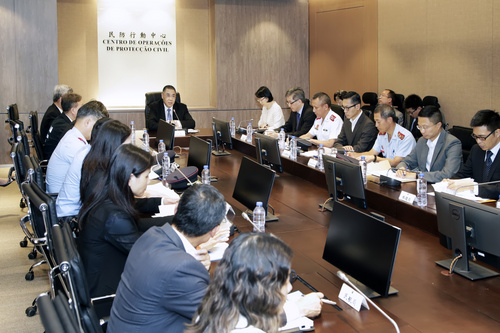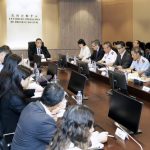 CE: Preparation work for Typhoon Mangkhut proves effective
CE: Preparation work for Typhoon Mangkhut proves effective
The Chief Executive, Mr Chui Sai On, said today that Macao‘s civil protection response to Typhoon Mangkhut achieved the expected results, helping to minimise the negative impact of the storm in the community.
Nonetheless, the Chief Executive asked the civil protection management team to further enhance the city’s overall emergency response capabilities, in order to reduce disruption caused by public emergencies to people’s everyday lives.
Mr Chui mentioned a number of ways further to optimise Macao’s emergency response capabilities, including: reinforcing existing infrastructure; speeding up construction of an internal barrier alongside the Inner Harbour, in order to strengthen flood control in the near term; and enhancing training for the team responsible for the city’s civil protection system.
The Chief Executive made the comments this afternoon during a meeting at the Civil Protection Operations Centre, focused on assessing the results of work carried out by the civil protection management team in dealing with two recent storms, in particular Typhoon Mangkhut. During the meeting, Mr Chui listened to suggestions from members of the civil protection management team regarding ways to improve the city’s emergency response plan.
In view of the adverse weather conditions caused by Typhoon Mangkhut, and the possibility of severe damage to Macao, the Government used its utmost effort, including preparing an emergency response plan well in advance, in order to minimise the negative impact of the powerful storm on the community.
As a result, there were no significant typhoon-related economic losses, injuries or damages. Typhoon Mangkhut caused the suspension of electricity and water supply to some neighbourhoods, and flooding in some of the city’s low-lying areas.
Mr Chui said the Government had made significant progress in managing prevention and mitigation work in case of public emergency situations, particularly compared to the response in dealing with Typhoon Hato in August last year.
The Chief Executive said an effective emergency response plan also required the participation of the community. Members of the public stood in unity with the Government in dealing with Typhoon Mangkhut, he said.
The concerted effort from the community was proof of the public’s level of awareness regarding public emergencies as well as their confidence in the Government’s guidance in dealing with the challenges brought about by such events.
The Government’s preparedness effort and dedication to ensuring the safety of the public and maintaining social order during the passage of Typhoon Mangkhut were widely recognised in the community, stated Mr Chui.
The Chief Executive extended his heartfelt gratitude, on behalf of the Government and in his personal capacity, to civil servants, including those in the civil protection system, for their dedication to protect the safety of the general public.
Mr Chui also spoke highly of the post-typhoon recovery work. A pre-arranged communication mechanism involving community associations and volunteer groups helped organising effectively the clean-up and recovery work, thus contributing to restore the people’s lives to normal as quickly as possible.
Officials attending today’s meeting were: the Secretary for Security, Mr Wong Sio Chak; the Commissioner-General of the Unitary Police Service and commander of the joint civil protection operations, Mr Ma Io Kun; the Director-General of the Macao Customs, Mr Vong Iao Lek; the Chief-of-Office of the Chief Executive’s Office, Ms O Lam; and representatives of the civil protection management team.


